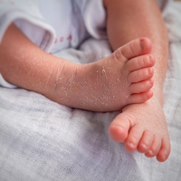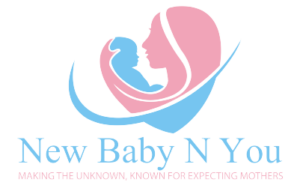Many parents notice newborn dry skin and skin peeling in the days following birth. Remember, over the past nine months, your baby has developed to survive inside the womb. But now, they must grapple with the climate of the outside world. It’s natural for their bodies to change and adapt to suit these new conditions. Newborn skin peeling is one of the most visible ways your baby’s body will adjust. In this blog post, we’re sharing everything you need to know about newborn dry skin, so you can enjoy the blissful newborn period without worrying about newborn skin peeling.
Why do newborns get dry skin?
Inside the womb, several fluids cover your baby as a form of protection. These fluids include amniotic fluid, blood, and vernix. After birth, the nurse or midwife will wipe your baby down, removing these protective fluids. Vernix is the fluid on the skin’s surface that protects against amniotic fluid. Once vernix is removed, your newborn’s skin will begin to peel. The extent of this peeling will vary between newborns and depends on the stage your baby was born. Premature babies tend to have more vernix on the skin, meaning it will take longer for their skin to peel. However, overdue babies have less vernix, so their skin will likely peel soon after birth.
Possible skin conditions
The main cause of newborn skin peeling and dry skin is the removal of vernix. However, there are other possible reasons for newborn dry skin.
Your baby might have developed a skin condition, such as Eczema or Ichthyosis. Although these aren’t common straight after birth, they can develop in the weeks or months following. Signs of a skin condition are redness, itching, scaly, or shedding skin. If you think your newborn has a skin condition, discuss this with a medical professional. Following this, they’ll be able to provide the right treatment and baby lotions to help manage your baby’s condition.
Other reasons for newborn skin peeling
Just as the outside climate affects our skin, it can impact our babies too. Exposure to cold air can dry out the skin, causing skin peeling. You might also notice patches of dry skin around your newborn’s face; this is likely due to spitting and drooling.
There are multiple causes of newborn dry skin, and it’s natural for your baby to experience these as they adapt to the outside world.
How to treat newborn skin peeling
Newborn skin peeling should naturally go away on its own. If your baby has dry skin due to the absence of vernix, their outer layer of skin will shed over a few days. Once this weak layer is gone, a new, stronger layer of skin will replace it.
Alternatively, if their dry skin is a result of external factors or drooling, you can make small changes to your routines to benefit your baby’s skin. The colder months are harsher on the skin, so always make sure your baby is wrapped up warm. Water exposure can dry out the skin. If you think this might be one of the reasons your newborn is experiencing skin issues, bathe less frequently and make sure you’re using clean, warm water. Harsh chemicals must be avoided during the newborn stage. If you’re looking for a treatment to use on your baby, a hypoallergenic baby lotion is suitable for locking in moisture after a bath.
Newborn dry skin is completely natural and shows your baby is adapting to life outside the womb. If you’re noticing patches of peeling or dry skin on your newborn baby, it’s likely nothing to worry about.
However, if you still have concerns regarding your newborn baby’s skin and how best to treat it, you can seek advice from the New Baby N You community, or speak with a medical professional. At New Baby N You, we provide you with everything you need to know about looking after a newborn in easy with our newborn health care videos, digestible chunks, so you can keep focusing on bonding with your beautiful new baby.


